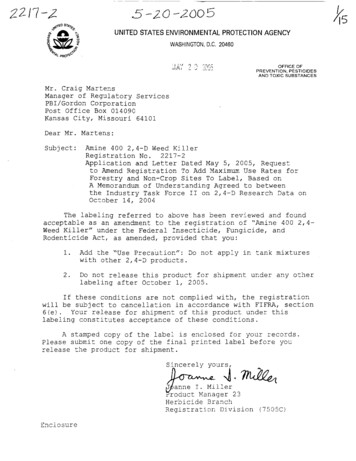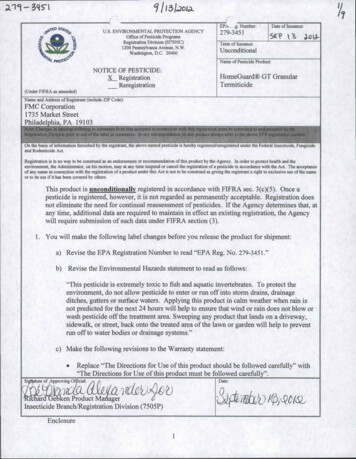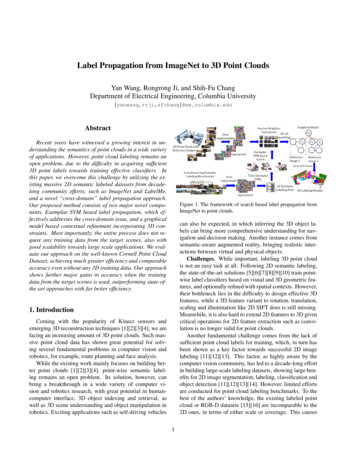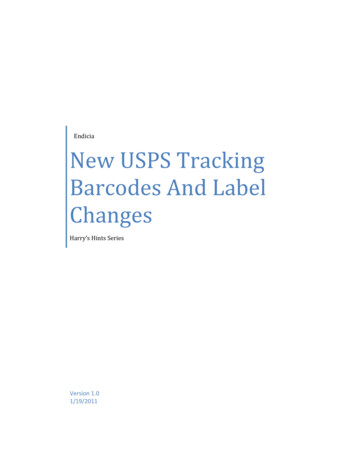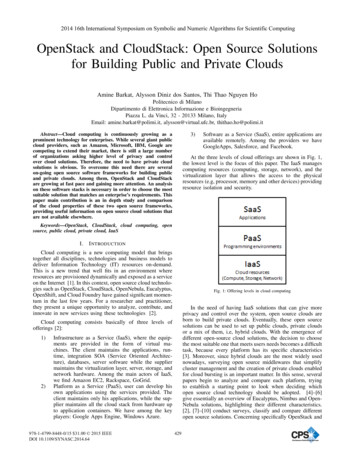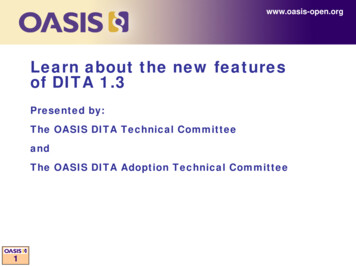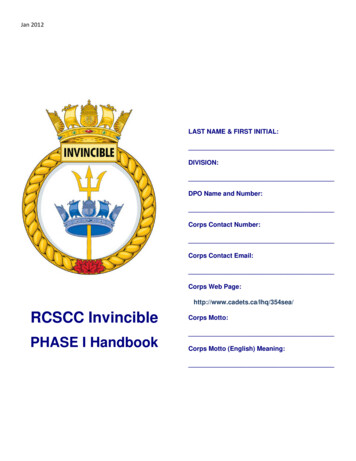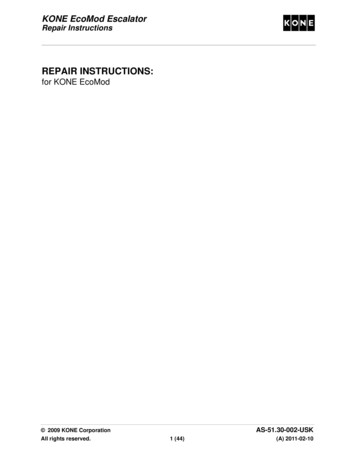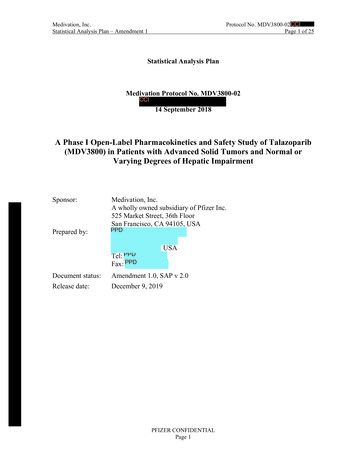
Transcription
Protocol No. MDV3800-02CCIPage 1 of 25Medivation, Inc.Statistical Analysis Plan – Amendment 1Statistical Analysis PlanMedivation Protocol No. MDV3800-02CCI14 September 2018A Phase I Open-Label Pharmacokinetics and Safety Study of Talazoparib(MDV3800) in Patients with Advanced Solid Tumors and Normal orVarying Degrees of Hepatic ImpairmentSponsor:Prepared by:Medivation, Inc.A wholly owned subsidiary of Pfizer Inc.525 Market Street, 36th FloorSan Francisco, CA 94105, USAPPDTel: PPDFax: PPDDocument status:Release date:USAAmendment 1.0, SAP v 2.0December 9, 2019PFIZER CONFIDENTIALPage 1
Protocol No. MDV3800-02CCIPage 2 of 25Medivation, Inc.Statistical Analysis Plan – Amendment 1Revision HistoryVersionVersion1.0Date06 March 2017PPDAuthor(s)Summary of Changes/CommentsN/A. This is the original SAP based onthe final protocol dated August 9th,2016.Version2.09 December 2019PPDAmended to include updates fromProtocol Amendment (v5.0, September14, 2018) and add details for plannedanalysis.PFIZER CONFIDENTIALPage 2
Protocol No. MDV3800-02CCIPage 3 of 25Medivation, Inc.Statistical Analysis Plan – Amendment 1TABLE OF CONTENTSLIST OF TABLES.4LIST OF FIGURES .4APPENDICES .41. INTRODUCTION .72. STUDY OBJECTIVES.82.1. Primary Objective .82.2. Secondary Objective .83. STUDY DESIGN AND METHODS .83.1. PK Evaluable Patients .93.2. Collection of Plasma Concentration.103.3. Study Endpoints .113.3.1. Pharmacokinetic Endpoints .113.3.2. Safety Endpoints.113.4. Randomization .113.5. Sample Size Justification .113.6. Data Handling .123.6.1. Concentrations Below the Limit of Quantification .123.6.2. Deviations, Missing Concentrations and Anomalous Values.123.6.3. Pharmacokinetic Parameters.124. DATA ANALYSIS.144.1. Analysis Populations .144.2. Study Patients .144.3. Patient Demographics .154.4. Baseline Definition.154.5. Medical/Surgical History and Procedures/Non-Drug Therapies .154.6. Prior and Concomitant Medications.154.7. Treatment Compliance .164.8. Pharmacokinetic Analysis .164.8.1. Plasma and Urine Concentrations.164.8.2. Pharmacokinetic Parameters.174.8.3. Comparative Analyses of PK Parameters.18PFIZER CONFIDENTIALPage 3
Protocol No. MDV3800-02CCIPage 4 of 25Medivation, Inc.Statistical Analysis Plan – Amendment 14.9. Efficacy Analysis .194.10. Safety Analysis.194.10.1. Study Product Exposure/Administration .194.10.2. Adverse Events .194.10.3. Clinical Laboratory Assessments .204.10.4. Vital Signs Assessments .214.10.5. Resting 12-Lead ECGs .214.10.6. Physical Examinations.214.10.7. ECOG Performance Status .214.11. Interim Analysis .214.12. Statistical Programming and Deliverables .224.13. Changes to the Planned Analysis .225. REFERENCES .23LIST OF TABLESTable 1.Group Assignment .9Table 2.PK Parameters .17LIST OF FIGURESFigure 1.Study Schema .10APPENDICESAppendix 1. Table 1.24PFIZER CONFIDENTIALPage 4
Protocol No. MDV3800-02CCIPage 5 of 25Medivation, Inc.Statistical Analysis Plan – Amendment 1Glossary and Amount of drug excreted in urine from time 0 to 24 hours expressedas percentage of administered doseAmount of unchanged drug excreted into urine from 0 to 24 hoursAdverse EventAlanine Aminotransferase/GPTAbsolute Neutrophil CountAnalysis of CovarianceAnalysis of Variance(Activated) Partial Thromboplastin TimeAspartate Transaminase / GOTAnatomical Therapeutic ChemicalArea under the concentration-time curveArea under the concentration time curve from time 0 to 24 hoursArea under the free concentration time curve from 0 to 24 hoursUnbound AUC0-24Body mass indexBelow Quantification LimitBlood Urea NitrogenDrug concentration in urine from time 0 to 12 hoursDrug concentration in urine from time 12 to 24 hoursConfidence intervalCreatinine ClearanceApparent Oral ClearanceRenal ClearanceUnbound CL/FCentimeterMaximum observed plasma concentrationUnbound CmaxPlasma trough (pre-dose) concentrationTotal plasma concentration of drugunbound concentration of drugCoefficient of variationDay 1Day 22Deoxyribonucleic acidElectrocardiogramsEastern Cooperative Oncology GroupElectronic Case Report FormEstimated Glomerular Filtration RateEnd of StudyFood and Drug AdministrationFraction of unbound drug in plasmaPFIZER CONFIDENTIALPage 5
Protocol No. MDV3800-02CCIPage 6 of 25Medivation, Inc.Statistical Analysis Plan – Amendment 1AbbreviationGamma GTH or minMinmLMDV3800MRTMTDn or NNCI mGamma-glutamyl transferase or gamma-glutamyl transpeptidaseHourHepatitis B surface AntigenHigh Density PolyethyleneHuman Immunodeficiency VirusInternational Normalized Ratio/Prothrombin timekilogramLactate dehydrogenaseLower limit of quantificationSquare meterMaximum Administered DoseMaximumModification of Diet in Renal DiseaseMedical Dictionary for Regulatory ribMean residence timeMaximum Tolerated DoseNumber of patientsNational Cancer Institute Common Terminology Criteria for AdverseEventsNot DoneNo SamplePoly (ADP-ribose) polymerasePharmacokinetic(s)Accumulation ratioSerious Adverse EventsStatistical Analysis PlanStandard DeviationSafety Follow UpTerminal half-lifeTotal bilirubinTreatment Emergent Adverse EventTables, Listings and FiguresTime to CmaxULNV0-12urV12-24urWBCWHOUpper limit of normalUrine volume from time zero to 12 hoursUrine volume from time 12 to 24 hoursWhite Blood CellsWorld Health OrganizationCCIPFIZER CONFIDENTIALPage 6
Protocol No. MDV3800-02CCIPage 7 of 25Medivation, Inc.Statistical Analysis Plan – Amendment 11. INTRODUCTIONTalazoparib (also known as BMN 673 and MDV3800) is a poly (ADP-ribose) polymerase(PARP) inhibitor being developed for the treatment of a variety of human cancers. PARPrepresents a family of at least 17 enzymes that transfer ADP-ribose groups to target proteinsto regulate various cellular processes including deoxyribonucleic acid (DNA) repair. Amongthem, PARP1 and PARP2 play important roles in DNA repair.PARP inhibitors exert cytotoxic effects by 2 mechanisms, (1) inhibition of PARP1 andPARP2 catalytic activity, and (2) PARP trapping, whereby PARP protein bound to a PARPinhibitor does not readily dissociate from DNA, preventing DNA repair, replication, andtranscription.The study drug, talazoparib, is a potent, orally bioavailable small molecule poly PARPinhibitor in development for the treatment of a variety of human cancers both as single agentand in combination with DNA-damaging chemotherapy.The pharmacokinetics (PK) of talazoparib as a single agent were evaluated in 142 adultpatients with hematologic malignancies and solid tumors at doses of 0.025 to 2 mg/dayadministered orally, as a single dose or as multiple doses. The PK was similar in patients ofeach cancer type and no differences were apparent between males and females. Oralabsorption of talazoparib was rapid and independent of dose after administration of single ormultiple doses. Elimination appeared to follow biphasic kinetics. At 1 mg/day, the meanterminal half-life (t½) was approximately 89.8 hrs. Following repeated administration at 1mg/day, the median talazoparib accumulation ratio (Rac) ranged from 2.23 to 12.3. Apparentoral clearance (CL/F) of talazoparib appeared to be dose linear. A food-effect studyconducted at 0.5 mg/day in healthy volunteers showed that food had no clinically meaningfuleffect on the extent of absorption (AUC) of talazoparib.PK studies have shown that overall, plasma talazoparib concentrations increase in a dosedependent manner. After a daily administration of talazoparib 1 mg, it took approximately 3weeks to reach the steady state. Based on phase 1, in vitro and in vivo preclinical data,talazoparib appears to predominantly excrete via the renal route. Therefore, it seems that thedrug is minimally metabolized in the liver following multiple dose intakes. However, thepotential effect of hepatic impairment on human PK of talazoparib is not known as mostclinical studies exclude patients with liver impairment.This study is designed to provide pharmacokinetic and safety data following dailyadministration of talazoparib in cancer patients with varying degrees of hepatic impairment.The study is carried out in patients with advanced solid tumors with normal liver functionand with mild, moderate and severe hepatic dysfunction as classified using the NationalCancer Institute Organ Dysfunction Working Group (per the NCI-ODWG) criteria. Basedon the results of this study, talazoparib dosing recommendations for patients with impairedliver function may be provided to future treating clinicians.PFIZER CONFIDENTIALPage 7
Protocol No. MDV3800-02CCIPage 8 of 25Medivation, Inc.Statistical Analysis Plan – Amendment 1The dose selected in this study is 0.5 mg/day which is considered a safe dose as it is lowerthan the Maximum Tolerated Dose (MTD) established in patients with normal hepaticfunction at 1 mg/day. Talazoparib has also shown clinical efficacy at this dose level in aphase 1 study. Talazoparib will be given for 22 days in order to assess the safety and PK oftalazoparib at the steady state.This statistical analysis plan (SAP) covers the detailed procedures for performing statisticalanalyses and for producing tables, listings, and figures (TLFs) in the study.2. STUDY OBJECTIVES2.1. Primary Objective To investigate the effect of mild, moderate or severe hepatic impairment on thepharmacokinetics of talazoparib following daily oral dosing of talazoparib for22 calendar days in patients with advanced solid tumors.2.2. Secondary Objective To evaluate the safety and tolerability of talazoparib in patients with advanced solidtumors and with normal, mild, moderate or severe hepatic impairment.3. STUDY DESIGN AND METHODSThis is an open-label, non-randomized, multi-center, phase 1 trial to investigate the PK andthe safety of talazoparib in patients with advanced solid tumors and impaired hepaticfunction.Safety and PK data from patients with mild, moderate and severe hepatic impairment asclassified using the NCI-ODWG criteria for hepatic impairment will be compared with acontrol group consisting of patients with normal hepatic function.Patients will be assigned to one of four groups based on their hepatic function. Hepaticfunction defined for each group as per the NCI-ODWG classification is presented in Table 1.PFIZER CONFIDENTIALPage 8
Protocol No. MDV3800-02CCIPage 9 of 25Medivation, Inc.Statistical Analysis Plan – Amendment 1Table 1.Group AssignmentGroupDescriptionPatients*AControl, normal hepatic function: Totalbilirubin (TB) and aspartate aminotransferase(AST) upper limit of normal (ULN)6 (8)BMild hepatic dysfunction: TB ULN and AST ULN or TB 1.0 to 1.5 ULN and any ASTvalue6 (8)CModerate hepatic dysfunction: TB 1.5 to 3.0 ULN and any AST value6 (8)DSevere hepatic dysfunction: TB 3 ULN andany AST value6 (0)* The patient number in the parenthesis will be assigned if Group D is halted due to safety.Study periods include: Screening; Enrollment (D-1); A 22 day treatment period, and A safety follow up visit (also called as the End of Study visit) which will occurapproximately 30 days (window -3/ 10 days) after the last study drug administrationor before initiation of a new anticancer therapy, or enrollment into the talazoparibopen-label extension (OLE) study, whichever occurs first.In each group, 6 patients will be treated with a daily oral dose of talazoparib 0.5 mg for atleast 22 calendar days counted from Day 1 (date of first study drug administration). Iftreatment in the group of patients with severe hepatic dysfunction (Group D) is halted due tosafety, 2 additional patients will be enrolled in each of Groups A, B and C (total of 8 PKevaluable patients in each group). Therefore, a total of at least 24 patients will be enrolled inthe study.3.1. PK Evaluable PatientsPatients will be considered PK Evaluable if they meet all the following criteria: Completed the Day 22 visit; Missed less than 5 consecutive doses;PFIZER CONFIDENTIALPage 9
Protocol No. MDV3800-02CCIPage 10 of 25Medivation, Inc.Statistical Analysis Plan – Amendment 1 Received at least 10 consecutive days of 0.5 mg talazoparib daily dose immediatelypreceding D22 visit without dosing interruption; At least 85% of total plasma PK samples collection is reported.Patients who discontinue the study before the completion of the Day 22 assessment and/orwho do not meet the above-mentioned criteria may be replaced if needed, upon agreement ofthe Sponsor.3.2. Collection of Plasma ConcentrationSerial PK plasma samples will be collected at predetermined times on Day 1 and Day 22 upto 24 hours post-dose (Day 2 and Day 23, respectively) for talazoparib concentrationmeasurement during which time the patients will be confined to the clinical research facility.Additionally, trough (pre-dose) samples will be collected on Day 8 and Day 15. One PKblood sample will also be collected at the Safety Follow up Visit (also called the End ofStudy visit) if the study treatment discontinues earlier than planned.Blood samples for plasma protein binding evaluation will be collected on Day 1 and Day 22(2h post-dose).Urine samples for PK analyses will be collected as a single void at pre-dose on Day 1 and allurine voided after talazoparib dosing on Days 1 and 22 at the intervals of 0-12 hours and 1224 hours.The study schema is shown in Figure 1.Figure 1. Study SchemaFor a detailed description of study procedures, please refer to protocol Section 7 “STUDYVISITS AND ASSESSMENT.PFIZER CONFIDENTIALPage 10
Protocol No. MDV3800-02CCIPage 11 of 25Medivation, Inc.Statistical Analysis Plan – Amendment 13.3. Study Endpoints3.3.1. Pharmacokinetic EndpointsPrimary EndpointsTalazoparib plasma PK parameters: AUC0-24, Cmax, AUC0-24u, and Cmaxu at steady state (onDay 22).Secondary EndpointsPlasma talazoparib:Single-dose parameters: AU0-24, Cmax, Tmax, fu, AUC0-24u, and Cmaxu;Multiple-dose parameters: Ctrough, Tmax, fu, Rac, CL/F, and CLu/F.Urine talazoparib:Single-dose parameters: Ae0-24 and Ae0-24%;Multiple-dose parameters: Ae0-24, Ae0-24%, and CLr.Additional PK parameters will be calculated as applicable.3.3.2. Safety EndpointsAny events occurring following start of treatment or increasing in severity will be counted astreatment emergent.Events that occur in a non-treatment period (for example Follow-up) will be counted astreatment emergent and attributed to the previous treatment taken. The safety will beevaluated based on the assessments of adverse events (AEs), vital signs, 12-leadelectrocardiograms (ECGs), laboratory assessments and Eastern Cooperative OncologyGroup (ECOG) performance status.3.4. RandomizationNo randomization will be conducted in the study.3.5. Sample Size JustificationPatients are assigned to one of four groups, based on hepatic function. The study will enroll6 PK evaluable patients (evaluability criteria are included in Section 3) with advanced solidtumors per group. If enrollment for severe hepatic dysfunction group is halted due to safety,2 additional evaluable patients will be enrolled in each of Groups A, B and C (total of 8evaluable subjects in each group). Therefore at least 24 patients will be enrolled.Non-evaluable patients may be replaced if needed upon agreement of the Sponsor.PFIZER CONFIDENTIALPage 11
Protocol No. MDV3800-02CCIPage 12 of 25Medivation, Inc.Statistical Analysis Plan – Amendment 13.6. Data HandlingFor the analysis of safety endpoints, the sponsor data standard rules for imputation will beapplied for missing values.3.6.1. Concentrations Below the Limit of QuantificationIn all data presentations (except a few specific scenarios listed below), concentrations belowthe quantification limit (BQL) will be set to zero. In data listin
Medivation, Inc. Protocol No.MDV3800-02 Statistical Analysis Plan –Amendment 1 Page 7of 25 PFIZER CONFIDENTIAL Page 7 1.INTRODUCTION Talazoparib (also known as BMN 673 and MDV3800) is a poly (ADP-ribose) polymerase (PARP) inhibitor being developed for the treat


